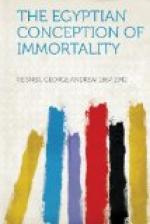Such fantastical reconstructions of the other world, however, never found general favor and are confined to a few royal tombs. The priests and other prominent people have rolls of papyrus buried with them, bearing copies of books of the dead. These books of the dead are made up of a series of chapters, each complete in itself and each dealing with some phase of the future life. There is no set order of chapters. There is no fixed number of chapters. Each scribe seems to have selected the chapters which he considered useful. The general title is: Chapters of the going forth by day. The general character may be given by a paragraph attached to one of the chapters in the Book of Ani the Scribe [Edited by E. A. W. Budge, p. 26]: “If this book be known on earth and written on the coffin, it is my mouth. He shall come forth by day in any form he desires and he shall go into his place without being prevented. There shall be given to him bread and beer and meat upon the altar of Osiris. He shall enter in, in peace, to the field of Earu according to this decree of the one who is in the City of Dedu. There shall be given to him wheat and barley there. He shall flourish as he did upon earth. He shall do his desires like these nine Gods who are in the underworld, as found true millions of times. He is the Osiris: the Scribe Ani.”
There are chapters to overcome all the evil which a soul may encounter; there are words to greet all the gods whom the soul desires to visit. The Scribe Ani had an exceptional position on earth; he desires to do his desire in the other world; and in the names of Osiris he recites the magic words that bring him the power. He is Ani, but he calls himself Osiris; just as the priestly doctor mixes his dose of medicine and calls it “the eye of Horus tested and found true.”
In addition to magical texts, there are also magical, or symbolic, objects placed in the graves,—amulets of various kinds which were to be used in the other world. Some of these were simply the amulets used in daily life to guard against sickness, bite of snake, and other earthly evils which were also incident to the life after death. Other amulets, like the so-called Ushabtiu, were to meet special conditions of the other world. These Ushabtiu, or “answerers,” were little images of workmen bearing agricultural implements whose duty it was to take the place of the dead in the fields of Earu when Osiris as king called him to do his share of the field work. Even the king appears liable to this service, and for him thousands of these figures were made,—sometimes labeled each with the day of the year. In a few cases there was even a charm written on the figure to prevent it hearing the command of any one but its master.




